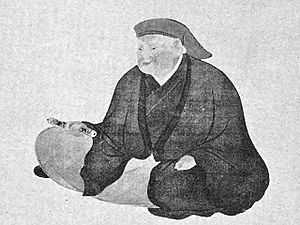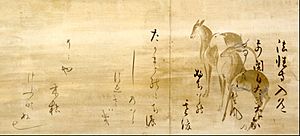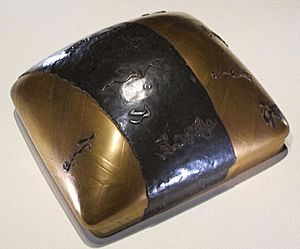Hon'ami Kōetsu facts for kids
Quick facts for kids
Hon'ami Kōetsu
本阿弥 光悦 |
|
|---|---|
 |
|
| Born | 1558 |
| Died | 27 February 1637 |
| Nationality | Japanese |
| Known for |
|
|
Notable work
|
|
| Movement | Rinpa school |
Hon'ami Kōetsu (Japanese: 本阿弥 光悦; 1558 – 27 February 1637) was a very talented Japanese artist. He was skilled in many different crafts, including pottery, lacquer work, and calligraphy. His unique artistic style is often seen as the starting point for the famous Rinpa school of painting.
A well-known art critic, Robert Hughes, once said that Kōetsu is a "national treasure" in Japan. This means he is extremely famous and important there, like a superstar artist! However, in many other parts of the world, like the United States, not many people know about his amazing work.
Contents
Kōetsu's Early Life
Hon'ami Kōetsu was born in 1558 in Kyoto, Japan. His family had a very special job: they were experts at polishing and judging swords. They worked for important leaders and the Emperor during a time called the Sengoku period (1467–1603). Some of these powerful leaders included Tokugawa Ieyasu and Oda Nobunaga.
For many generations, Kōetsu's family followed the Nichiren sect of Buddhism. They were big supporters of a temple founded by a priest named Nisshin. Kōetsu continued this family tradition and supported the temple throughout his life.
Kōetsu's grandfather was a trusted advisor to the Shōgun Ashikaga Yoshimasa. His father, Hon'ami Kōji, received money from the Maeda family for his skills in judging swords. Kōetsu also continued this connection with the Maeda family. He would give them advice on swords, paintings, and other beautiful art objects. Through these connections, Kōetsu met many important people in the art world, including the famous tea master Kobori Enshū.
Kōetsu also loved the Nō theater. This is a traditional form of Japanese musical drama. He became close with the Kanze family of actors, who lived near his family's home. He might have even performed in Nō plays himself. He also designed many items for the actors and the theater.
Amazing Artistic Skills
Even though Kōetsu was trained to polish swords, he became skilled in many other arts. He was very interested in the Japanese tea ceremony, which had become popular again thanks to the tea master Sen no Rikyū. Kōetsu became one of the best students of another tea master, Furuta Oribe. He was especially good at making a type of pottery called Raku ware.
Kōetsu even received clay from Donyu II, whose grandfather was the first Raku potter. Kōetsu used the traditional Raku style but added his own unique touch to his tea bowls. One of his tea bowls, called "Fuji-san," is so special that it is considered a National Treasure in Japan.
Kōetsu was also one of the greatest calligraphers of his time. Calligraphy is the art of beautiful handwriting. He was inspired by the old court writings from the Heian period. He learned from Prince Sonchō, who taught him the style of a famous Chinese calligrapher named Wang Xizhi. Kōetsu created many works in a flowing, cursive style. Along with two other artists, Konoe Nobutada and Shōkadō Shōjō, he was known as one of the "Three Brushes of the Kan'ei Era" (寛永の三筆, kan'ei no sanpitsu). Kōetsu not only used classical styles but also developed his own special way of writing, which he taught to his students.
Lacquer work was another area where Kōetsu was very creative. Lacquer is a type of varnish used to decorate objects. At first, his lacquer designs were traditional. But later, he started using new and exciting techniques. He often used materials like tin, lead, gold, and mother-of-pearl in his designs.
Working with Other Artists
Hon'ami Kōetsu worked closely with the painter Tawaraya Sōtatsu. Sōtatsu often decorated Kōetsu's calligraphy with beautiful gold leaf and paint. They worked together for about fifteen years. Some experts even think they might have been related by marriage. Sōtatsu was a very important artist in the Rinpa school, and his paintings likely show some of Kōetsu's influence and style.
An Artist Community
In 1615, Hon'ami Kōetsu started a special community for artists. It was located northwest of Kyoto, in a place called Takagamine. The land was given to him by Tokugawa Ieyasu. Experts are not sure if this community was mainly for art or for religion, especially Nichiren Buddhism. Some even wonder if the land grant was a gift or a way to send him away.
No matter the reason, it was in this community that Kōetsu developed his unique artistic style. This style later grew into the famous Rinpa school. The community was called Taikyo-an. It was used for prayer and meditation, as well as being a place for artists to create. Many important people, including the historian Hayashi Razan, visited Kōetsu there. After Kōetsu passed away in 1637, his grandson, Hon'ami Kōho, returned the land to the government, and the community ended.
Kōetsu's Legacy
Ernest Fenollosa, one of the first American art collectors and critics of Japanese art, believed that Hon'ami Kōetsu was one of the few artists from his time who could be compared to the great masters of earlier periods.
Hon'ami Kōetsu was also shown and mentioned in the Japanese film Samurai II: Duel at Ichijoji Temple. This movie was about the life of the famous samurai, Miyamoto Musashi.
See also
 In Spanish: Honami Kōetsu para niños
In Spanish: Honami Kōetsu para niños





